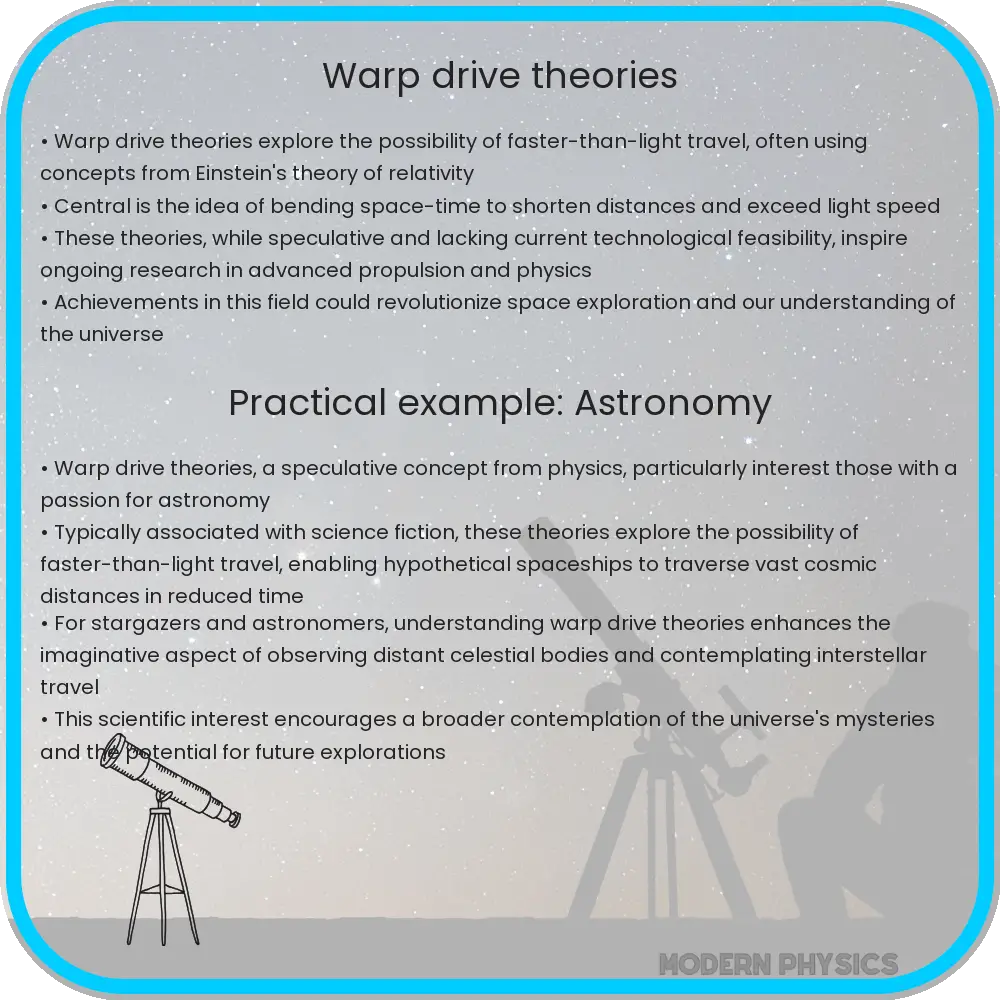Warp drive theories explore the concept of faster-than-light travel by manipulating space-time, aligning with principles of speed, space-time, and relativity.

Warp Drive Theories: Speed, Space-Time & Relativity
Interstellar travel has been a tantalizing concept explored in science fiction for many years. One of the most intriguing ideas proposed to make this possible is the warp drive. This theoretical propulsion system would allow spacecraft to travel faster than the speed of light by manipulating space-time itself. Let’s explore how warp drive theories align with the principles of speed, space-time, and relativity.
The Concept of Warp Drive
The warp drive idea rose to prominence thanks to science fiction series like Star Trek, but it has some roots in physics. Fundamentally, a warp drive could theoretically create a bubble of space-time around a spacecraft, contracting space in front of it and expanding space behind it. This would allow the spacecraft to travel vast distances without moving faster than the speed of light within its local space-time bubble.
Speed and Space-Time
In traditional physics, the speed of light, approximately 299,792 kilometers per second (km/s), is considered the ultimate speed limit. Nothing with mass can travel faster than this speed, according to Einstein’s theory of relativity. However, warp drive theories suggest an alternative by bending or distorting space-time to achieve such rapid travel. This concept is often depicted using the analogy of a rubber sheet representing space-time, where the warp drive pinches and folds the sheet to short-cut the path.
Relativity and the Warp Drive
Einstein’s theory of relativity, which consists of special relativity and general relativity, serves as the foundation for understanding how warp drives could work. Special relativity introduces the equation:
E = mc2
where E is energy, m is mass, and c is the speed of light. This equation implies that as an object approaches the speed of light, its mass effectively becomes infinite, requiring infinite energy to further accelerate it. This renders faster-than-light travel impossible by conventional means.
General relativity, on the other hand, explains how mass and energy warp space-time, illustrated by the famous equation:
Gμν + Λgμν = \frac{8πG}{c^4} Tμν
Here, Gμν represents the Einstein tensor, Λ is the cosmological constant, gμν is the metric tensor, G is the gravitational constant, c is the speed of light, and Tμν is the energy-momentum tensor. This equation suggests that space-time can be curved by mass and energy, theoretically allowing for the creation of a warp bubble.
One of the most referenced theoretical models of a warp drive is the Alcubierre Drive, proposed by physicist Miguel Alcubierre in 1994. Alcubierre’s mathematical model suggested that a spacecraft could achieve faster-than-light travel by contracting space in front of it and expanding it behind. This would create a “warp bubble” in which the spacecraft resides, moving it to a distant point in space-time without locally violating the light speed limit.
The mathematical foundation for the Alcubierre Drive is based on solutions to Einstein’s field equations in general relativity, where a specific metric, known as the Alcubierre metric, describes the space-time curvature around the warp bubble:
ds2 = -c2dt2 + [dx – v_s(t)f(r_s)dt]2 + dy2 + dz2
In this metric, v_s(t) represents the warp bubble velocity, and f(r_s) is a function defining the shape of the warp bubble. Although theoretically sound, the practical implications of Alcubierre’s model present significant challenges.
One of the primary obstacles for an operational warp drive is the immense amount of energy it would require. Alcubierre’s original calculations estimated that the energy equivalent to the mass of the entire universe would be needed to generate a warp bubble. Moreover, this exotic matter would likely involve negative energy densities, which have not been proven to exist in the necessary quantities.
Proposed Solutions and Challenges
Since Alcubierre’s initial proposal, physicists have been researching ways to reduce the extreme energy requirements of warp drive technology. Some theoretical modifications suggest that using more efficient geometries or new types of exotic matter might lower the energy needed. Nonetheless, these solutions remain purely speculative and face significant hurdles both in terms of our current understanding of physics and practical engineering challenges.
Potential Implications of Warp Drive Technology
If warp drive technology could be realized, it would revolutionize space exploration and human civilization. Traveling to other stars and possibly inhabiting exoplanets would become feasible within a human lifetime. This could lead to unprecedented scientific discoveries and new frontiers for humanity. However, these benefits must be weighed against potential risks, such as unintended consequences of manipulating space-time or the ethical considerations of such powerful technology.
Conclusion
Warp drive theories captivate our imagination and push the boundaries of our understanding of physics and engineering. While concepts like the Alcubierre Drive offer a tantalizing glimpse into faster-than-light travel, the scientific and technological challenges remain formidable. Theoretical research continues to explore these ideas, but practical implementation is likely a distant goal, if achievable at all. However, the pursuit of such ambitious concepts can inspire advancements in fundamental physics and engineering, potentially leading to breakthroughs that could transform our approach to interstellar travel in the future. For now, warp drives remain a fascinating intersection of science fiction and theoretical physics, encouraging us to dream big and explore the unknown.
